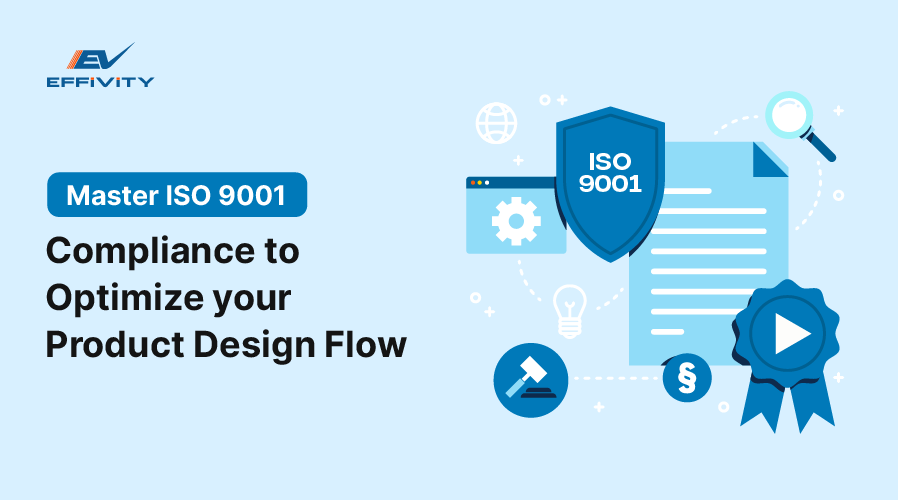Are you about to design and launch a new product? Read this before you begin! The process of designing a new product is exciting. A new product drives new business, making your organization stand out from the competition. However, every new design must be subject to rigorous testing to confirm that it meets quality standards. This starts with aligning your process with ISO 9001 design and development requirements.
ISO 9001 design and development sets a high bar. It lists a set of practices to manage and control the design and development of products or services. Your organization must meet the regulatory requirements for the design flow to qualify as ISO 9001 compliant.
In this blog post, we explain how to optimize your design process and use quality management software in your product development cycle.
What is the Product Design and Development Process?
The product design and development process is a framework your business can use to create new products or to improve existing ones. While each company has a different design and development process, some steps are common.
When you design a product, the first step is often generating an idea. The idea is then fleshed out into a detailed concept. The actual designing and development happens after this. Once you are happy with the product, you must put it through design verification and validation to check that it works as needed. Lastly, you would produce the final product in bulk and launch it into the market.
ISO 9001 Design Process Flow
The ISO 9001 standard helps your organization design and develop new products in a way that prioritizes quality, meets regulations, and makes your customers happy. Here is how you can customize each step of your design process to meet ISO design requirements.

Step 1: Define Objectives and Scope
Start by establishing clear objectives and defining the scope of your new product. This step guides all the other steps, so make sure you do it carefully.
- Establish specific objectives like performance, cost, and compliance with relevant standards.
- Clearly list what the project will cover.
Step 2: Establish Design Requirements
Next, you have to specify the requirements for your design and development. You can collect these requirements from various sources, such as your customers, standards, regulations, and internal needs. Understanding the requirements your product must satisfy helps you design it better.
- Integrate customer needs and preferences through direct feedback and market research.
- Identify applicable industry regulations and safety standards.
- Consider your company's specific needs, like sustainability targets or integration with other product lines.
Step 3: Create a Design Plan
Now that you know your requirements, start planning out your design process. A good design plan outlines the approach and resources at every stage of the product development process.
- Define the design methodologies and tools you will use.
- Allocate human, technological, and financial resources necessary for the project.
- Set a detailed timeline with milestones to manage the pace and progress.
- Assign roles and duties to each team members for accountability.
Step 4: Design and Development Inputs
Design inputs are the characteristics that the new product would possess. These are based on the requirement. Simply, your design inputs specify how the product is used, by whom and in what way.
- Define what the product should do and how it should perform under various conditions.
- Specify how users will interact with various aspects of your product.
- Outline requirements for maintaining and servicing the product over its lifecycle.
Step 5: Design and Development Controls
Your product development procedures must meet quality standards to be ISO-compliant. For this, you must establish controls at various points in the design process.
- Set up regular review points to evaluate if the design follows all regulatory requirements.
- Conduct tests,quality assurance inspections and peer reviews to check that the design outputs meet the defined inputs.
- Ensure the product performs as intended in its actual usage environment.
Step 6: Design and Development Outputs
The results of your design and development processes are called outputs. These outputs must align with your inputs. At this stage, you must carefully document all results and observations to maintain quality guidelines.
- Include all technical documentation for manufacturing.
- Provide clear instructions for production.
- Outline necessary quality controls and testing procedures.
Step 7: Design Review
Every new design has to be put through review cycles to check if it meets all requirements. These reviews help you assess your design progress and make adjustments along the way.
- Evaluate if the project milestones are being met.
- Discuss and resolve any design challenges that have emerged.
- Decide whether to proceed as planned or change design strategies.
Step 8: Design Verification and Validation
Post review, you must conduct verification and validation before finalizing your design. If the product fails to meet requirements, the design will have to be changed and placed for a fresh review cycle.
- Tests and simulations are used to confirm that the product meets all design specifications.
- Use trials, user feedback, and performance testing to ensure the product fulfills its purpose.
Step 9: Control of Design and Development Changes
In case any changes have been made to your design after the verification process, you have to manage these changes carefully and ensure that they have been implemented.
- Record all changes made to the design, including reasons and effects.
- Review changes to ensure they meet all necessary standards.
Step 10: Transfer to Production
Now that all the other ISO 9001 design and development steps have been completed, you can transfer all documentation to the manufacturing. They can automate the manufacturing production process with the help of quality management software.
- Ensure all product design documentation is handed over so that production processes can be accurate.
- Train the production team on any new techniques or technologies used in the design.
Final Thoughts
The ISO 9001 design and development process guarantees the creation of high-quality products that comply with all international standards and regulations. To comply with the ISO standard, you must pay particular attention to every detail in each step of your production process.
Using quality management system software can make the design process more efficient. It automates documentation, allows you to collaborate in real-time, access data from anywhere and tracks your compliance. This can help you focus entirely on the creative side of the design process and create a product that reflects your organization's passion for innovation.






























